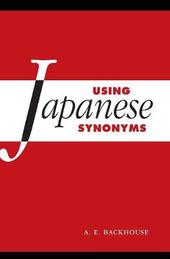
|
Using Japanese Synonyms
Hardback
Main Details
| Title |
Using Japanese Synonyms
|
| Authors and Contributors |
By (author) A. E. Backhouse
|
| Physical Properties |
| Format:Hardback | | Pages:458 | | Dimensions(mm): Height 254,Width 178 |
|
| Category/Genre | Grammar and syntax |
|---|
| ISBN/Barcode |
9781107147065
|
| Classifications | Dewey:495.681 |
|---|
| Audience | | Tertiary Education (US: College) | | Professional & Vocational | |
|---|
|
Publishing Details |
| Publisher |
Cambridge University Press
|
| Imprint |
Cambridge University Press
|
| Publication Date |
16 June 2016 |
| Publication Country |
United Kingdom
|
Description
Being a successful speaker of a given language involves control of the meaning and use of vocabulary items, taking in their lexical content (what phenomena they refer to), combinatorial behaviour (what items they occur with) and situational characteristics (e.g. as colloquial or formal terms). This essential reference book provides clear information on these aspects for around three hundred groups of Japanese near-synonyms, supplemented by a wide range of authentic examples. The result is a clear profile of the meaning and use of each item, highlighting similarities and distinctions among neighbouring terms and expanding learners' lexical range. The book is designed primarily for English-speaking learners, and the selection of groups and items and the overall treatment adopted reflects the author's extensive experience in teaching Japanese to English speakers. Japanese forms and examples appear in both romanisation and Japanese orthography, and the bilingual indexes allow readers to locate synonyms quickly and easily.
Author Biography
A. E. Backhouse is Professor Emeritus at Hokkaido University. Educated in the UK, he has taught Japanese language and linguistics at universities in Australia and Japan since 1975. He has published extensively in the fields of Japanese language and applied linguistics.
Reviews'Using Japanese Synonyms is a thesaurus and reference for the intermediate and advanced student of Japanese. The hundreds of words and authentic examples are organized into approximately 300 semantic frames, which range literally from A (abunai) to Z (zenzen). Within each frame, the words and examples are chosen to highlight potential problems of understanding and differentiation for English-speaking learners. Meaning and register are explicitly addressed. The volume includes two indices for easy access and cross-referencing, and it can be used for self-study or in a classroom setting.' William McClure, Queens College, City University of New York
|